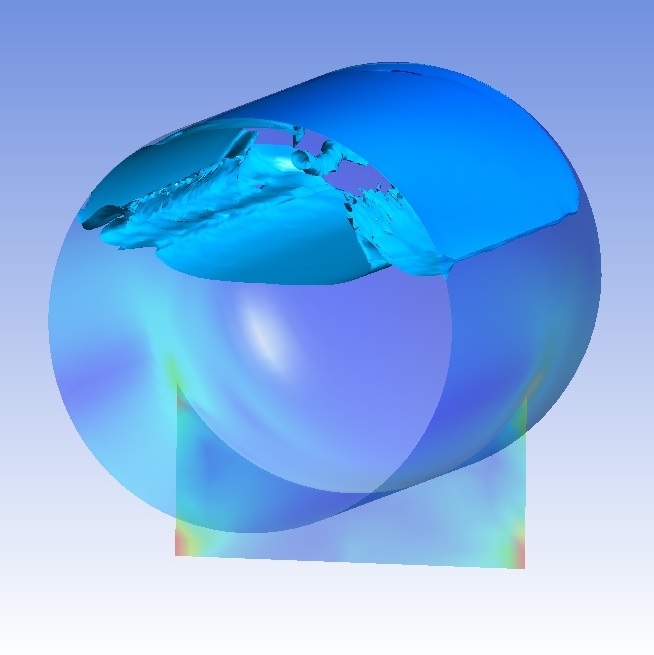Ansys Pressure Vessel Pdf Editor

Main geometric parameters of pressure vessel shell and nozzle are shown in Table.I and Table.II. Table.III presents design parameters of pressure vessel. A 3D solid model of pressure vessel with a nozzle is created by using design modeler of ANSYS software, which is shown in fig. GUI ANSYS Parametric Design Language is used as it easier to assign the mechanical properties of materials, etc.100% Fig 3.1: Radial stress of cylindrical part of the FGM pressure pressure vessel truncated Fig 3.2: Radial stress of spherical part of the FGM pressure vessel Fig 3.3: Comparison of radial displacement for 5°, 10°.
This tutorial is an educational tooldesigned to assist those who wish to learn how to use the ANSYS finiteelement software package. It is not intended as a guide for determiningsuitable modelling methods or strategies for any application. Theauthors of this tutorial have used their best efforts in preparing thetutorial. These efforts include the development,research and testing of the theories and computational models shown in the tutorial.
The authors make no warranty of any kind, expressed orimplied, with regard to any text or models contained in this tutorial. Theauthors shall not be liable in any event for incidental orconsequential damages in connection with, or arising out of, the furnishing,performance, or use of the text and models provided in this tutorial.There is no gaurantee that there are no mistakes or errors in theinformation provided and the authors assume no responsibility for theuse of any of the information contained in this tutorial.Overview. In this tutorial you will examine theexpansion of a pressure vessel due to an internal pressure using ANSYS. The problem is adapted from case study E on page 327 of the textbook Practical Stress Analysis with Finite Elements (2nd Ed)by Bryan J. You will determine the principal stresses in the pressure vessel due to the applied loading and boundary conditions.
A two-dimensional plane strain element will be used for this analysis. We will use SI system units for this tutorial:length = m, mass = kg, time = sec, force = N, stress/pressure = Pa. Inthis case the vessel is made from steel (E = 207 Gpa, v = 0.27) and the internal pressure is 10,000 Pa.
Figure 1: Details of the Pressure Vessel - all dimensions in mm.There are standard theories available for the behaviour of thin andthick walled cylinders subjected to internal pressure. These equations can befound in any text book on mechanics of solids or in any reference book. We can use these theories to predict the expected stresses in the pressure vessel due to the applied loading. The calculations for the various stresses is shown on pages 328 to 329 of Practical Stress Analysis with Finite Elements (2nd Ed)by Bryan J. Mac Donald and is summarised in the table below.
Figure 2 shows an overview of the plane strain model of the pressure vessel. The model on the left hand side is a full plane strain model of a slice through the pressure vessel. By recognising the symmetry in the problem we can reduce this model to a 1/4 symmetry plane strain model as shown on the right hand side of figure 2. In this tutorial, we will build the 1/4 symmetry plane strain model as it easily allows for the application of boundary conditions (which are not so easily applied to the full model). Note: if the background of your screen is black then that is not a problem.
In the image above reverse video has been used. If you want to use reverse video (i.e. Canon mg3100 manual. Have a white background) then simply go to: Utility Menu PlotCtrls Style Colors Reverse VideoStep 6: Mesh the Geometry. In the Main Menu click on Preprocessor Meshing Mesh Tool.This will open the Mesh Tool window.
We are now going to use the Mesh Tool to set the size of the elements toall be a constant size before we begin the meshing process. In the MeshTool click on Areas Set as shown in the figure below. Step 7: Apply the Boundary Conditions. In the Main Menu click on Preprocessor Loads Define Loads Apply Structural Displacement Symmetry B.C. Step 9: Solve the Problem.In the Main Menu select Solution Analysis Type New Analysis.Make sure that Static is selected in the dialog box that pops up and then click on OK to dismiss the dialog.Select Solution Solve Current LS to solve the problem.Anew window and a dialog box will pop up.
Take a quick look at theinfromation in the window ( /STATUS Command) before closing it.Click on OK in the dialog box to solve the problem.Once the problem has been solved you will get a message to say that the solution is done, close this window when you are ready.Step 10: Examine the Results.In the Main Menu select General Postproc Plot Results Deformed Shape. Select Def + undef edge in order to show both the deformed and undeformed shapes.Your screen should look something like this.